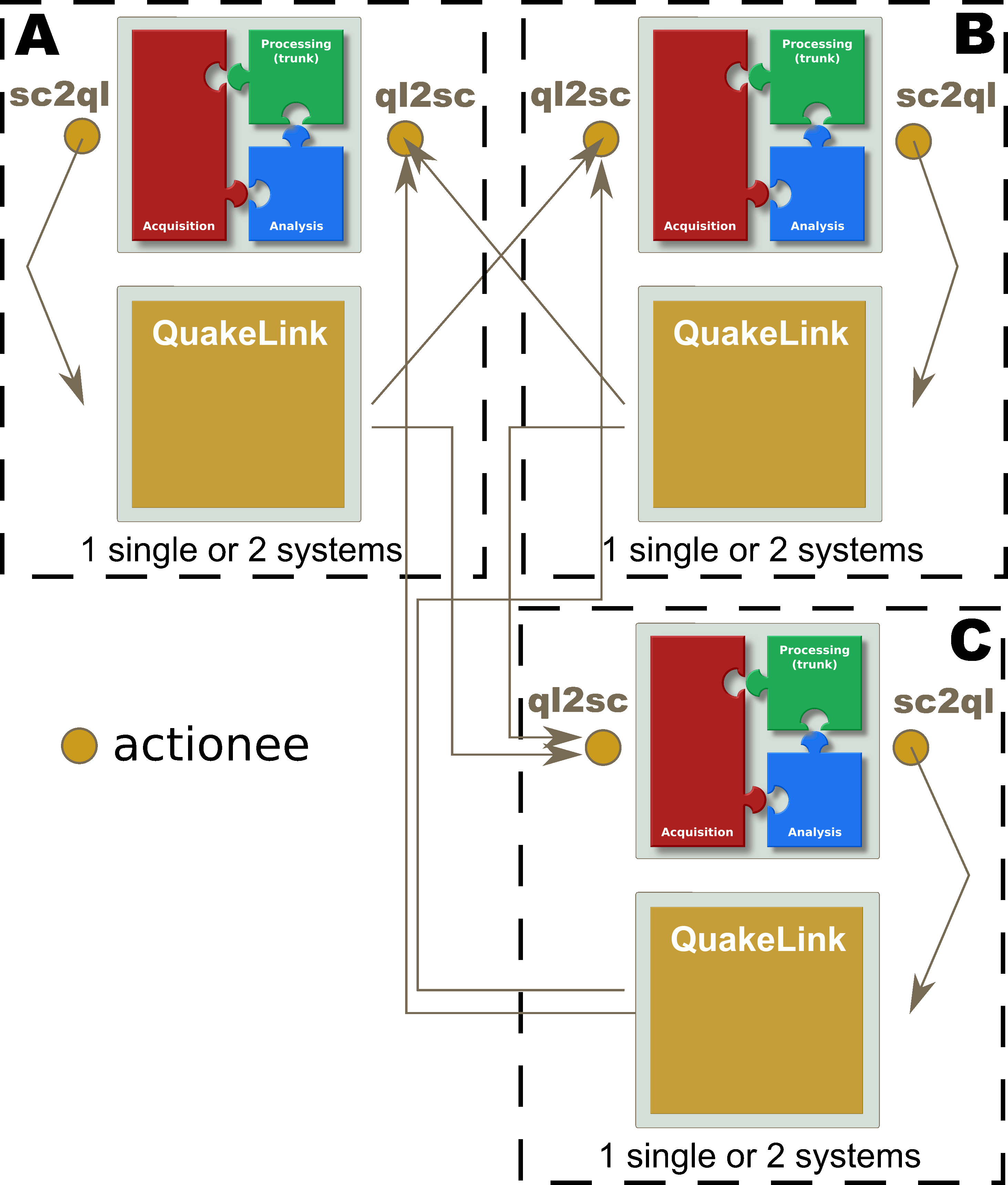Examples¶
3-Systems setup¶
Goal: Parameter exchange between 3 separate SeisComP systems (A, B, C)
Setup:
Run one QuakeLink instances along with each separate SeisComP system.
sc2ql delivers the own Origins to own QuakeLink instance.
ql2sc [1] imports Origins from remote QuakeLink instance and sends them to the own messaging system.
scevent [3] on the own system associates all Origins.
Check the parameters example of the 1+2 system setup for the detailed setup parameters at system A. Repeat for the system B and C.

Figure 2: 3-System setup.¶
1+2 Systems setup¶
Parameter exchange at agency A with agencies B, C. Configuration at agency A.
Goals:
Push Event parameters of agency A to own QuakeLink instance running on the same machine of agency A.
Agency A allows secure connection from agencies B, C to QuakeLink at A.
Import Origins from agencies B and C to A.
Parameters:
Global configuration in
global.cfgagencyID = A
scevent [3] configuration in
scevent.cfg# Configures a timespan in seconds to delay event creation. If a new origin # arrives which cannot be associated to an existing event, delay the event # creation for a certain timespan. eventAssociation.delayTimeSpan = 10 # The agencyID of the origin to be delayed. eventAssociation.delayFilter.agencyID = B,C
ql2sc [1] configuration in
ql2sc.cfgDecide whether to use secure connection (example: hostB) or non-secure connection (example: hostC).
# Defines a whitelist of agencies that are allowed for processing separated by # comma. processing.whitelist.agencies = B,C # Registration of QuakeLink hosts. hosts = hostB,hostC # URL of the QuakeLink service, the scheme 'qls' enables SSL. # Format: [ql[s]://][user:pwd@][host][:port]. # If set to an empty string the application will run without any QuakeLink # connection attempt. host.hostB.url = qls://user:passwd@remotehostB:18010 # Request server to send keep alive messages to prevent connection reset by # firewalls on long idle periods. host.hostB.keepAlive = true # SQL like WHERE clause to filter the result set. # clause := condition[ AND|OR [(]clause[)]] __ condition := # MAG|DEPTH|LAT|LON|PHASES|OTIME|UPDATED [op float|time]|[IS [NOT] NULL] __ op # := =|>|>=|<|<=|eq|gt|ge|lt|ge __ time := %Y,%m,%d[,%H,%M,%S,%f] host.hostB.filter = "MAG > 5.0 AND AGENCY != 'A'" # Request native data instead of XML format. Native data export may be disabled # on some hosts. host.hostB.native = true # Tries to update the event attributes of the target event with the attributes # of the source event which includes event type and event certainty. It will # not import events but tries to find the associated event of the input # preferred origin at the target system and will update the event attributes # via journaling. host.hostB.syncEventAttributes = false # URL of the QuakeLink service, the scheme 'qls' enables SSL. # Format: [ql[s]://][user:pwd@][host][:port]. # If set to an empty string the application will run without any QuakeLink # connection attempt. host.hostC.url = ql://remotehostC:18010 # Request server to send keep alive messages to prevent connection reset by # firewalls on long idle periods. host.hostC.keepAlive = true # Request native data instead of XML format. Native data export may be disabled # on some hosts. host.hostC.native = true # Tries to update the event attributes of the target event with the attributes # of the source event which includes event type and event certainty. It will # not import events but tries to find the associated event of the input # preferred origin at the target system and will update the event attributes # via journaling. host.hostC.syncEventAttributes = false
quakelink configuration in
quakelink.cfg:# Port to listen for data requests QL.port = 18010 # Port to listen for plugin data feeds QL.pluginPort = 18011 # Path to the access control file. Format: Multiples lines of form 'KEY = # VALUE'. # KEY: '[DOMAIN].ALLOW|DENY'. VALUE: comma-separated list of IP addresses or # network masks. DOMAIN: Allowed values: 'PLUGINS, COMMANDS, URLS'. PLUGINS: # Access control of plugin data connections. COMMANDS: Allowed values: 'SET, # FORMAT::[NATIVE, GZNATIVE, SUMMARY, XML, GZXML], INFO::[CLIENTS, EVENTS, # OPTIONS]'. QL.access-list = @ROOTDIR@/etc/quakelink-access.cfg # Port to listen for data requests with SSL QL.SSL.port = 22 # Path to SSL certificate file QL.SSL.certificate = "xyz..." # Path to SSL private key file QL.SSL.key = "xyz..." # Path to the SSL users database (same format Apache users file). The tool # htpasswd can be used with switch "-d" to force usage of crypt() function. MD5 # is currently not implemented. QL.SSL.users = "xyz..." # Port to listen for HTTPS request QL.https.port = 22
Push external events to QuakeLink¶
Goal: Populate the QuakeLink database with the event parameters existing in a file in SCML format. database of a particular type and on a particular host [type://user:password@host/database].
Solution: use qlpush. Example:
qlpush -H localhost:18011 events.xml
Import events from an external SeisComP¶
Goal: Read events back in time from a remote QuakeLink server on demand and provide the parameters to QuakeLink in local system.
Solution: use ql2sc [1]. The remote is configured in
ql2sc.cfg. Example for fetching events from the past 10 days from quakelink which are sent to a SeisComP system:ql2sc --backLog 864000 --debug
Retrieve event information from a QuakeLink server¶
Goal: Connect to quakelink to fetch the updated event parameters for an event from the QuakeLink server.
Solution 1: use qltool. Example for fetching the parameters from event gempa2018abcd and storing in a SCML file:
qltool -E gempa2018abcd > gempa2018abcd.xml
Solution 2: use the download button in the event browser of the QuakeLink web interface.